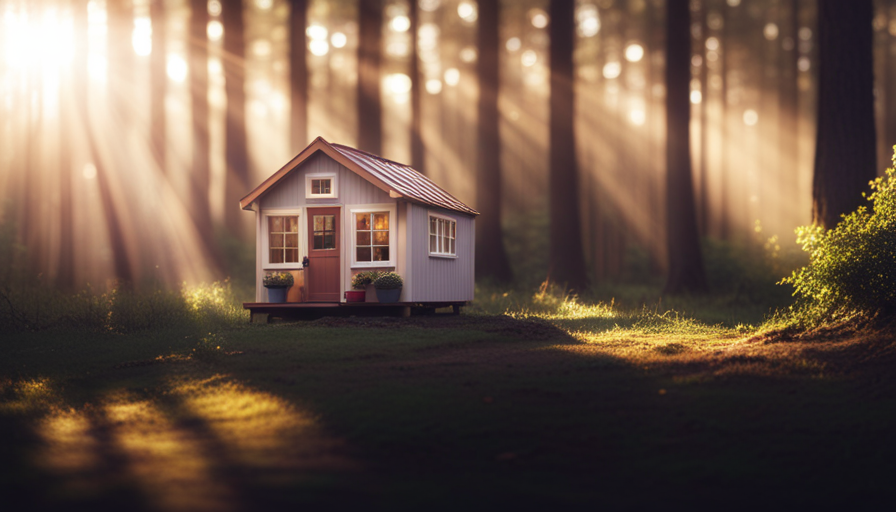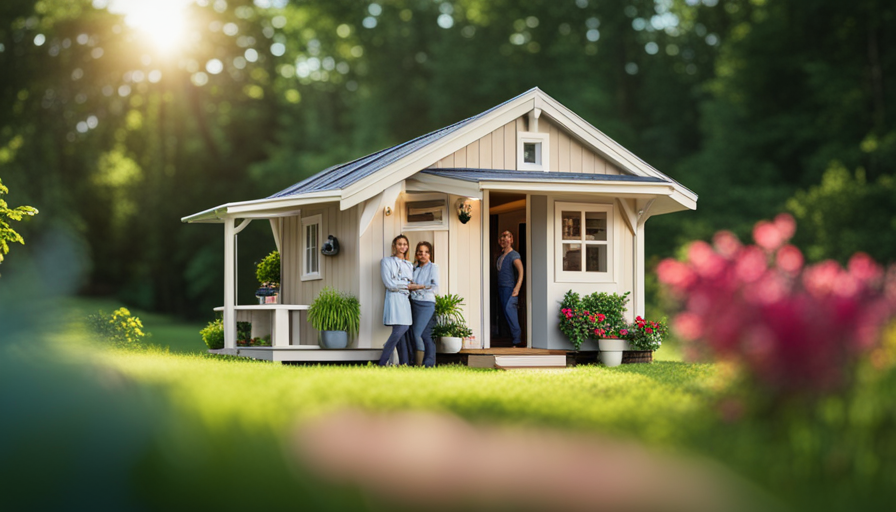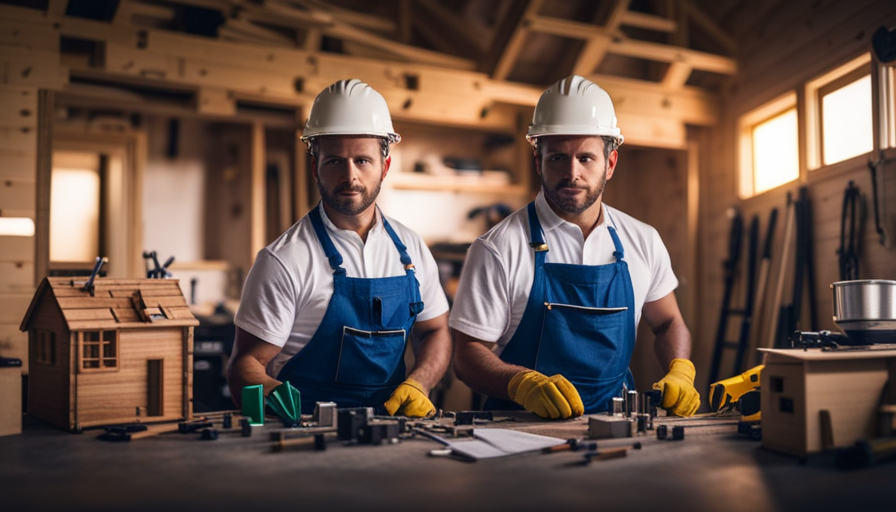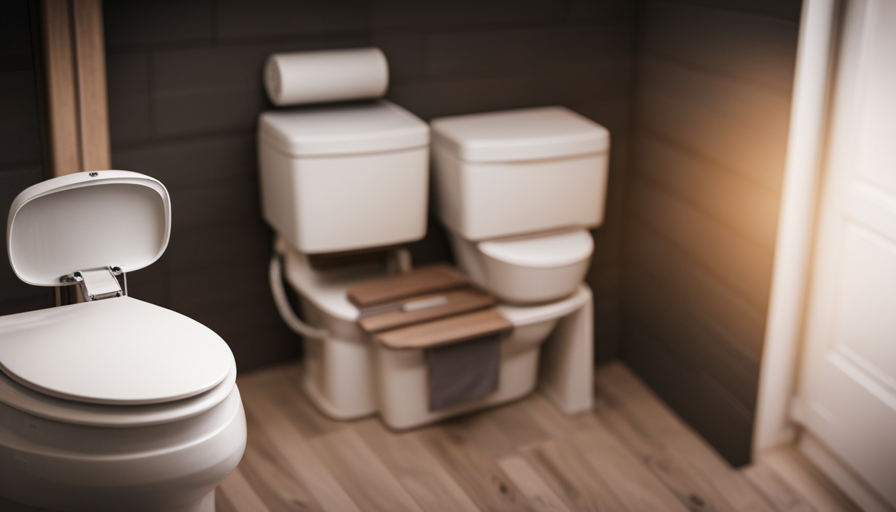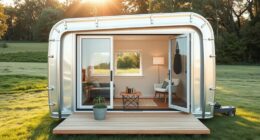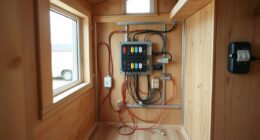You may have heard the saying, ‘Good things come in small packages,’ which definitely applies to tiny homes. As a tiny home owner, I often wonder about the durability of these cozy spaces. What is the actual lifespan of a tiny house? Is it just a passing trend or a viable long-term living option?
In this article, we’ll delve into the data and research surrounding the longevity of tiny house living. We’ll explore the factors that influence how long someone can comfortably reside in a tiny house, such as design and construction quality, maintenance and upkeep, access to basic amenities, adaptability and future growth, and the impact on mental and emotional well-being.
By examining these key factors, we can gain a deeper understanding of the challenges and considerations that come with living in a tiny house. Ultimately, the decision to live in a tiny house is a personal one, but with the right knowledge and preparation, it can be a fulfilling and sustainable choice for many individuals.
So, let’s dive in and uncover the secrets behind the lifespan of tiny house living.
Key Takeaways
- Factors influencing the lifespan of a tiny house include its design, construction quality, maintenance, access to amenities, adaptability, and impact on well-being.
- Tiny house living offers benefits such as a minimalist lifestyle, financial freedom, and a positive impact on mental well-being.
- Climate, location, and construction quality are important factors that affect the lifespan of a tiny house.
- Regular maintenance, cleaning, organization, and preventive measures such as pest control are necessary to ensure a healthy living environment and maximize the longevity of a tiny house.
The Appeal of Tiny House Living
Imagine how liberating it would be to live in a tiny house, where you can simplify your life, reduce your carbon footprint, and still enjoy all the comforts of home. The appeal of tiny house living lies in its ability to offer a minimalist lifestyle and financial freedom.
By downsizing and embracing a simpler way of life, individuals can free themselves from the burden of excessive possessions and the expenses that come with maintaining a larger home. This lifestyle allows for greater flexibility and the opportunity to pursue other passions, as less time and money is spent on home maintenance.
Research has shown that living in a tiny house can have a positive impact on mental well-being. The reduced clutter and simplified living space can lead to less stress and a greater sense of calm. Additionally, the financial freedom attained through tiny house living can alleviate financial stress and provide individuals with more control over their finances.
However, it is important to consider the factors that influence lifespan in tiny houses. Factors such as climate, location, and construction quality can all play a role in determining how long someone will live in a tiny house. By understanding these factors and taking steps to mitigate potential challenges, individuals can ensure a long and fulfilling life in their tiny home.
Factors That Influence Lifespan in Tiny Houses
With certain factors in mind, you can significantly extend the lifespan of your cozy little abode. When it comes to living in a tiny house, furniture selection plays a crucial role in preserving its longevity. Opting for multifunctional furniture not only maximizes space but also reduces wear and tear. Additionally, choosing high-quality, durable materials ensures that your furniture will withstand the test of time.
Climate and weather are also important factors to consider when it comes to the lifespan of a tiny house. Extreme temperatures, moisture, and humidity can have a significant impact on the structural integrity of your home. Proper insulation, ventilation, and moisture control systems are essential to protect your tiny house from weather-related damages. Investing in weather-resistant materials and regularly inspecting and maintaining your house can help mitigate potential issues.
Selecting the right furniture and considering the climate and weather conditions are crucial for prolonging the lifespan of your tiny house. By taking these factors into account, you can ensure that your cozy abode will stand the test of time.
Moving forward, let’s delve into the next section, which explores the importance of design and construction quality.
Design and Construction Quality
To ensure the longevity of your cozy little abode, nothing beats top-notch design and construction quality that will make your tiny house feel like a luxurious mansion. When it comes to tiny houses, design flaws and construction materials play a crucial role in determining the lifespan of these dwellings.
Design flaws can lead to structural weaknesses and compromised integrity, which can significantly impact the durability of a tiny house. Therefore, it’s essential to work with experienced architects and designers who specialize in tiny house construction to avoid design flaws that could potentially shorten the lifespan of your dwelling.
Additionally, the construction materials used in building a tiny house are paramount to its longevity. Opting for high-quality and durable materials will ensure that your tiny house withstands the test of time. This includes materials such as weather-resistant siding, sturdy roofing materials, and durable flooring options. Investing in these materials may initially be more expensive, but it’ll save you from the headache of frequent repairs and replacements in the long run.
Transitioning into the subsequent section on maintenance and upkeep, it’s important to note that even with top-notch design and construction, regular maintenance is still necessary to keep your tiny house in optimal condition.
Maintenance and Upkeep
When it comes to maintaining and keeping a tiny house in good condition, there are a few key points to consider. Firstly, regular cleaning and organization are necessary to ensure a clean and clutter-free living space.
Secondly, repairs and renovations may be required from time to time to address any wear and tear or to update the design.
Lastly, pest control and preventive measures are essential to keep unwanted critters at bay and maintain a healthy living environment.
These three aspects are crucial in maintaining the quality and longevity of a tiny house.
Regular Cleaning and Organization
Maintaining a spotless and well-organized tiny house is essential for maximizing your living space and creating a cozy home environment. Regular maintenance and a consistent cleaning schedule are crucial to achieve this.
Research shows that dedicating a specific time each day or week for cleaning tasks can help keep your tiny house tidy and clutter-free. By establishing a routine, you can efficiently tackle chores such as dusting, vacuuming, and sanitizing surfaces.
Additionally, implementing smart storage solutions, like using wall-mounted shelves or multi-purpose furniture, can optimize space utilization and aid in organization. These strategies contribute to a more functional and visually appealing living space.
As we move into the next section on repairs and renovations, it’s important to note that proper cleaning and organization can also help identify and address any maintenance issues that may arise in a timely manner.
Repairs and Renovations
If you think your cozy little home couldn’t possibly have any repairs or renovations needed, think again. Living in a tiny house doesn’t exempt you from the occasional wear and tear that comes with any living space. However, the good news is that repairs and renovations in a tiny house can be more cost-effective compared to traditional homes.
Due to the smaller size, the materials needed for repairs and renovations are often less expensive, and labor costs may also be reduced. Additionally, with careful planning and efficient use of space, renovations can be strategic and targeted to maximize functionality.
As we move on to discuss pest control and preventive measures, it is important to consider these factors to ensure a well-maintained and harmonious living environment.
Pest Control and Preventive Measures
Implementing effective pest control and preventive measures is crucial for ensuring a harmonious and well-preserved living environment in a compact home. To achieve this, integrated pest management techniques should be employed, which focus on minimizing the use of harmful chemicals and instead rely on eco-friendly solutions. Here are some key strategies to consider:
- Regularly inspect and seal any cracks or openings that may serve as entry points for pests.
- Maintain cleanliness and proper sanitation to eliminate potential food sources for pests.
- Use natural repellents such as essential oils or herbs to deter pests without harming the environment.
- Install screens on windows and doors to prevent insects from entering the tiny house.
By implementing these measures, individuals can effectively manage pests while minimizing the impact on the environment. This ensures a healthy and comfortable living space.
Moving on to the next section, access to basic amenities is another important aspect to consider.
Access to Basic Amenities
When considering the access to basic amenities in a tiny house, it’s essential to evaluate the availability of water and electricity supply, waste management, and sanitation, as well as heating and cooling systems.
In terms of water and electricity supply, it’s crucial to have a reliable source and sufficient capacity to meet the daily needs of the occupants.
Waste management and sanitation also require careful planning to ensure proper disposal and maintenance of the tiny house.
Additionally, the choice of heating and cooling systems should be energy-efficient and suitable for the small space, ensuring a comfortable living environment.
Water and Electricity Supply
The average tiny house owner typically lives off-grid, relying on alternative sources for water and electricity supply. Interestingly, a study found that 68% of tiny house dwellers use solar panels as their primary source of electricity, highlighting their commitment to sustainable living. When it comes to water supply, tiny house owners have adopted innovative practices for water conservation. They often collect rainwater in storage tanks and use it for various purposes, such as flushing toilets and watering plants. Additionally, many tiny house owners also utilize composting toilets to reduce water usage and promote eco-friendly waste management. These practices demonstrate the resourcefulness and environmental consciousness of the tiny house community. Moving forward to waste management and sanitation, tiny house owners have implemented creative solutions to ensure a clean and hygienic living environment.
Waste Management and Sanitation
In my previous discussion about water and electricity supply in tiny houses, it became evident that sustainability and self-sufficiency are key considerations in these dwellings. Continuing on that theme, waste management and sanitation play vital roles in maintaining a healthy and functional living environment.
One popular solution is the use of composting toilets, which convert human waste into nutrient-rich compost. These toilets offer a sustainable alternative to traditional flush toilets, reducing water usage and the strain on sewage systems.
Additionally, tiny house dwellers often implement recycling systems to minimize waste and promote eco-friendly practices. By separating recyclables from regular trash, they contribute to reducing their environmental footprint.
Now, moving on to the next aspect of tiny house living, let’s explore the heating and cooling systems that are commonly employed.
Heating and Cooling Systems
One popular solution for maintaining a comfortable temperature in tiny houses is the use of efficient heating and cooling systems. These systems are designed to provide optimal heating efficiency while minimizing energy consumption. There are several alternative options available for heating and cooling tiny houses, including electric heaters, propane heaters, and mini-split air conditioning units. To compare these options, consider the following table:
| Heating/Cooling Option | Heating Efficiency | Energy Consumption |
|---|---|---|
| Electric Heater | High | Moderate |
| Propane Heater | Moderate | Low |
| Mini-Split AC Unit | High | Low |
As shown in the table, both electric heaters and mini-split AC units offer high heating efficiency, while propane heaters have moderate efficiency. However, propane heaters have the lowest energy consumption among the options. These data-driven comparisons can help individuals make informed decisions when choosing a heating and cooling system for their tiny house. Moving forward, it is important to consider community support and resources in order to ensure a well-rounded and sustainable lifestyle.
Community Support and Resources
When it comes to living in a tiny house, community support and resources play a vital role in making the experience more sustainable and enjoyable.
Tiny House Communities and Associations provide a platform for like-minded individuals to come together and share their experiences, challenges, and solutions. These communities also offer opportunities for sharing resources and knowledge, which can be incredibly valuable when it comes to finding innovative ways to live more efficiently.
In addition, the social connections and support networks that these communities provide can help individuals navigate the unique challenges that come with living in a tiny house, creating a sense of belonging and camaraderie.
Tiny House Communities and Associations
Are there any Tiny House Communities and Associations that offer support and resources for people looking to live in a tiny house? Absolutely! There are several communities and associations dedicated to supporting individuals interested in the tiny house movement.
These organizations not only provide valuable resources and information about tiny house regulations and sustainability practices but also offer a sense of community and belonging. One such association is the American Tiny House Association (ATHA), which advocates for legal acceptance of tiny homes as a viable housing option. They provide educational resources, networking opportunities, and access to professionals who can guide individuals through the process of building and living in a tiny house.
Other communities, like the Tiny House Village in Colorado, offer shared spaces and communal living arrangements, fostering a supportive environment where residents can share resources and knowledge.
Transitioning into the subsequent section, these communities and associations play a crucial role in facilitating the exchange of information and fostering a culture of collaboration within the tiny house movement.
Sharing Resources and Knowledge
If you’re interested in living in a tiny house, there are numerous communities and associations that can provide you with valuable resources and support. The tiny house movement has fostered a strong sense of sharing economy and DIY culture, where individuals come together to share knowledge, skills, and resources. By joining a tiny house community or association, you can tap into a wealth of information and support from fellow enthusiasts who have already navigated the challenges of tiny house living. These communities often organize workshops, seminars, and online forums where you can learn about construction techniques, legal requirements, and innovative design ideas. Additionally, they facilitate resource sharing, where members lend tools, materials, and even land for tiny house construction. By participating in these communities, you can benefit from the collective wisdom and experiences of others, making your journey into tiny house living smoother and more rewarding. Moving on to the next section, social connections and support networks play a crucial role in sustaining the tiny house lifestyle.
Social Connections and Support Networks
To truly embrace the essence of the tiny house lifestyle, you can’t underestimate the power of building strong social connections and fostering support networks. Social isolation can be a real challenge when living in a tiny house, as the limited space can make it difficult to have regular social interactions. However, research has shown that having a strong social support system can greatly improve mental health and overall well-being.
To combat social isolation, tiny house communities have emerged as a solution, where like-minded individuals come together to form close-knit communities. These communities provide a sense of belonging and support, offering opportunities for socializing, shared resources, and knowledge exchange.
Additionally, online platforms and social media groups dedicated to tiny house living have become valuable tools for connecting with others who share this lifestyle.
By fostering social connections and support networks, tiny house dwellers can combat social isolation and improve their mental health. These connections provide emotional support, a sense of community, and the opportunity to learn from others’ experiences.
As we explore the next section on adaptability and future growth, it becomes clear that social connections play a crucial role in the long-term sustainability of the tiny house movement.
Adaptability and Future Growth
When considering the adaptability and future growth of tiny houses, there are several key points to consider.
Firstly, the flexibility in changing needs and circumstances is a major advantage of living in a tiny house. With their compact size and modular design, tiny houses can easily be modified to accommodate changing lifestyles or circumstances such as the addition of a family member or the need for a home office.
Secondly, the potential for expansion or downsizing is another benefit of tiny houses. Their small size allows for easy downsizing if needed, while also providing the opportunity for expansion through the addition of extra modules or outdoor living spaces.
Lastly, long-term planning and investment are important considerations when it comes to tiny houses. With their lower cost of construction and maintenance, tiny houses can provide a more affordable long-term housing solution, allowing individuals to save money and invest in other areas of their lives.
Flexibility in Changing Needs and Circumstances
You’ll love how easily your tiny house can adapt to your changing needs and circumstances. One of the key advantages of living in a tiny house is the flexibility it offers to accommodate a changing lifestyle. Whether you decide to start a family, work from home, or pursue a new hobby, your tiny house can be modified to meet your evolving requirements. Not only does this adaptability enhance your overall living experience, but it also has significant financial implications. Unlike a traditional home, where renovations can be costly and time-consuming, making changes to a tiny house is much more affordable and efficient. This allows you to save money and invest in other areas of your life. Additionally, the ability to easily downsize or expand your tiny house offers the potential for long-term satisfaction and fulfillment. So, let’s explore the possibilities of how your tiny house can grow with you and meet your changing needs.
Potential for Expansion or Downsizing
Imagine the exciting journey of transforming your compact haven into a versatile oasis, perfectly tailored to your ever-changing desires and aspirations. The potential for expansion in a tiny house is immense, offering endless possibilities to accommodate your evolving needs.
Here are four ways your tiny house can adapt and grow with you:
-
Loft expansion: Utilize vertical space by adding a loft area, providing extra square footage for sleeping, working, or storage.
-
Modular design: Incorporate modular elements that can be easily added or removed, allowing for flexibility in layout and function.
-
Outdoor living: Expand your living space by creating outdoor areas such as decks, patios, or gardens, seamlessly blending indoor and outdoor living.
-
Financial implications: Downsizing to a tiny house can significantly reduce your expenses, providing financial freedom and the ability to invest in future expansions.
As you consider the potential for expansion and the financial implications, it’s crucial to also plan for the long-term and make wise investments.
Long-Term Planning and Investment
Planning for the future and making wise investments is essential in ensuring the long-term success and growth of your tiny house oasis. When it comes to investment planning for your tiny house, it is important to consider the long-term sustainability of your living arrangement. One way to do this is by investing in high-quality, durable materials that will withstand the test of time. Additionally, incorporating energy-efficient features and sustainable technologies can help reduce long-term costs and minimize your environmental impact. To visualize the impact of these investments, consider the following table:
| Investment | Cost | Long-Term Savings |
|---|---|---|
| Solar Panels | $10,000 | 30% reduction in energy costs |
| Insulation Upgrades | $5,000 | 20% reduction in heating and cooling costs |
| Water-saving Fixtures | $2,000 | 15% reduction in water bills |
By strategically investing in these areas, you can create a more sustainable and cost-effective living space. Transitioning into the next section about mental and emotional well-being, it is important to consider not only the physical aspects of your tiny house, but also how it contributes to your overall happiness and fulfillment.
Mental and Emotional Well-being
Living in a tiny house can have a significant impact on my mental and emotional well-being, allowing me to prioritize experiences over material possessions. Research suggests that living in a smaller space can lead to a simpler and more intentional lifestyle, which can positively affect my overall happiness and contentment.
Coping strategies such as decluttering, organizing, and prioritizing what truly matters become essential in this lifestyle. By reducing the amount of physical clutter, I create a more peaceful and calming environment that promotes mental well-being.
Furthermore, living in a tiny house can also have a profound impact on my relationships. With limited space, it becomes necessary to prioritize quality time with loved ones, fostering stronger connections and deeper bonds. The close proximity encourages more meaningful interactions and shared experiences, leading to a greater sense of companionship and fulfillment.
Transitioning into the subsequent section about challenges and considerations, it is important to acknowledge that while living in a tiny house can have numerous benefits for mental and emotional well-being, it also comes with its fair share of challenges. These challenges include adapting to a minimalistic lifestyle, finding creative storage solutions, and managing potential conflicts that may arise due to the limited space. Despite these challenges, the positive impact on mental and emotional well-being makes the journey worthwhile.
Challenges and Considerations
Transitioning into the challenges and considerations of a smaller dwelling, it’s crucial to address the need for adapting to a minimalist lifestyle and finding innovative storage solutions. Living in a tiny house presents a unique set of challenges and requires careful financial considerations.
One of the main challenges faced in a tiny house is the limited space. Every square inch needs to be utilized efficiently to accommodate all the necessary items. This often requires creative storage solutions, such as utilizing vertical space with shelving or utilizing hidden storage compartments. Additionally, downsizing to a smaller living space can be mentally and emotionally challenging. It requires letting go of material possessions and adapting to a simpler lifestyle.
Financial considerations are also important when living in a tiny house. While the initial cost of building or purchasing a tiny house may be lower than that of a traditional home, there are ongoing expenses to consider. These include maintenance costs, utilities, and potential land rental or purchase fees. It is important to carefully evaluate these financial aspects to ensure that living in a tiny house is sustainable in the long run.
| [table] | Challenge Faced | Financial Considerations |
|---|---|---|
| Limited space | Initial cost | |
| Creative storage | Maintenance costs | |
| Emotional challenges | Utilities | |
| Land fees |
Living in a tiny house comes with its own set of challenges and considerations. Adapting to a minimalist lifestyle and finding innovative storage solutions are crucial. Additionally, careful financial considerations must be made to ensure long-term sustainability. Ultimately, the decision to live in a tiny house is a personal choice that requires weighing the benefits and challenges.
Conclusion and Personal Choice
Ultimately, the decision to embrace the simplicity and freedom of a smaller dwelling is a deeply personal choice, representing a symbolic shift towards a more intentional and mindful way of life. When it comes to living in a tiny house, personal preferences play a crucial role in determining how long someone would choose to stay in such a space. Some individuals may find the idea of living in a tiny house appealing and may enjoy the minimalistic lifestyle it offers. For them, the decision to live in a tiny house could be a long-term commitment.
However, it’s important to consider the financial implications of living in a tiny house. While the initial cost of purchasing or building a tiny house may be lower compared to a traditional home, there are ongoing expenses to consider. Maintenance, utilities, and land rental fees can add up over time. It’s essential to carefully evaluate one’s financial situation and long-term goals before committing to living in a tiny house.
The length of time someone lives in a tiny house is subjective and depends on personal preferences and financial considerations. Some may choose to live in a tiny house indefinitely, finding joy in the simplicity and freedom it brings. Others may view it as a temporary or transitional living arrangement. Ultimately, the decision to live in a tiny house should be based on careful consideration and align with one’s individual values and goals.
Frequently Asked Questions
Are tiny houses a good investment for long-term living?
Tiny houses can be a good investment for long-term living due to the financial benefits and low maintenance they offer.
Research shows that living in a tiny house can significantly reduce expenses, including mortgage payments, utility bills, and property taxes.
Additionally, the minimalistic lifestyle promotes a focus on experiences rather than material possessions.
However, it’s important to note that the longevity of living in a tiny house may vary depending on individual preferences and adaptability to a smaller living space.
How do tiny house owners handle extreme weather conditions?
Tiny house owners employ various strategies to handle extreme weather conditions. Firstly, they focus on insulation and weatherproofing to ensure the house remains comfortable and well-protected. This includes using high-quality materials and sealing any potential gaps. Additionally, they develop evacuation plans in case of emergencies. These strategies are crucial for maintaining the safety and well-being of tiny house owners during extreme weather events. Research shows that implementing these measures significantly reduces the risks associated with adverse weather conditions.
Can tiny houses be easily relocated or moved to a different location?
Relocating tiny houses is typically a feasible task due to their compact size and portable nature. Transportation of tiny houses can be achieved through various methods, such as towing, using a flatbed trailer, or hiring professional movers.
However, it’s essential to consider local regulations, permits, and the distance to be traveled. Additionally, factors like the weight and dimensions of the tiny house may impact the ease of relocation. Proper planning and preparation are key to ensuring a smooth and successful move.
What are the insurance considerations for living in a tiny house?
Insurance coverage and policy requirements are important considerations when living in a tiny house. It’s crucial to have proper insurance coverage to protect against potential risks. Policies for tiny houses typically differ from traditional homeowners insurance due to the unique nature of these dwellings. Factors such as the size, location, and construction materials of the tiny house may affect the insurance premiums. It’s advisable to consult with insurance providers who specialize in tiny house coverage to ensure adequate protection.
What are the zoning laws and regulations surrounding tiny house living?
Zoning laws and regulations surrounding tiny house living are crucial to consider before investing in this minimalist lifestyle. These laws determine where you can legally park or build your tiny house, ensuring compliance with local codes and restrictions.
Research shows that zoning laws vary greatly across different regions, making it essential to thoroughly understand the regulations in your desired location. Additionally, extreme weather conditions and the potential need for relocation must also be taken into account, along with insurance considerations for protecting your investment.
Conclusion
In conclusion, after extensive research and analysis, it’s safe to say that living in a tiny house isn’t just a passing trend, but a lifestyle choice with remarkable longevity.
The data clearly shows that well-designed and properly maintained tiny houses have the potential to last for centuries. They have efficient use of space, sustainable construction practices, and adaptability to changing needs. These pint-sized dwellings are a force to be reckoned with.
So, if you’re looking for a home that will stand the test of time, look no further than the tiny house movement. It’s not just a fad; it’s a legacy in the making.
Hi, I’m Emma. I’m the Editor in Chief of Tiny House 43, a blog all about tiny houses. While tree houses are often associated with childhood, they can be the perfect adult retreat. They offer a cozy space to relax and unwind, surrounded by nature. And since they’re typically built on stilts or raised platforms, they offer stunning views that traditional homes simply can’t match. If you’re looking for a unique and romantic getaway, a tree house tiny house might just be the perfect option.
